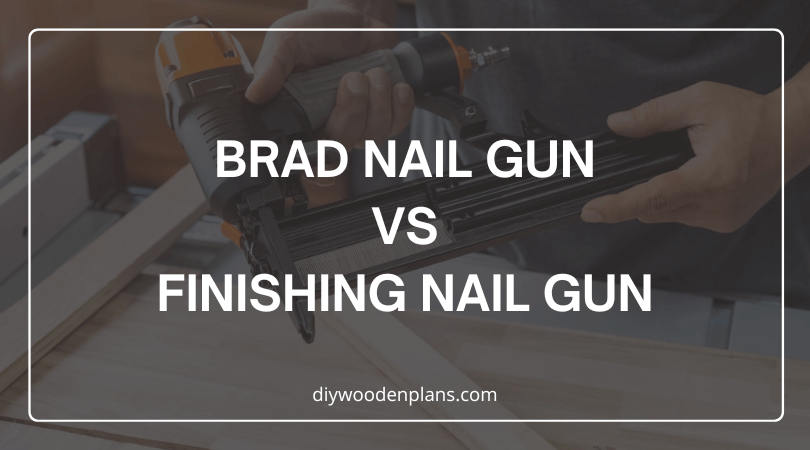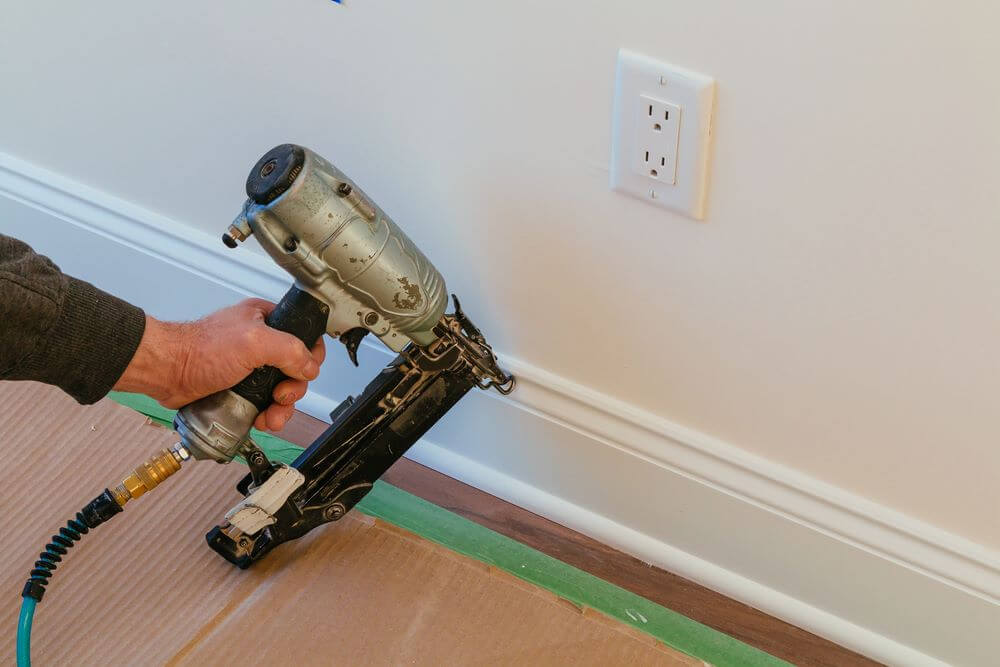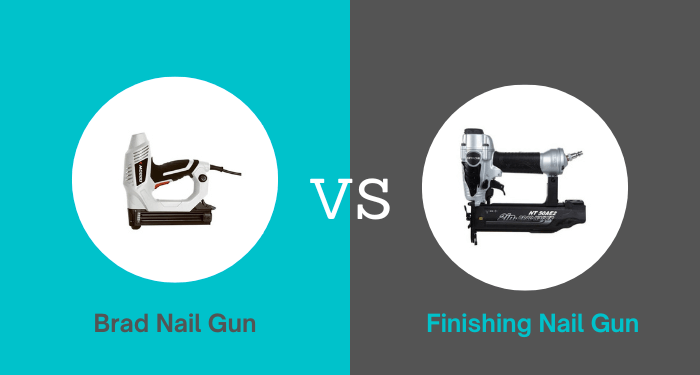YOUR NO 1 WOODWORKING POWER TOOLS RESOURCE WEBSITE
Brad Nail Gun vs Finishing Nail Gun: Which Nailer is Right For You?

Disclosure: If you click on some of the links, we may earn a small referral fee. Please know that we only recommend products that we use and believe will add value to our readers.
If you are a woodworker or a homeowner interested in doing DIY renovations, you will come across a brad nail gun vs finishing nail gun. These two tools look quite similar, but they have their differences. To choose the best nail gun for your needs, you should understand their differences and applications.
Here is a comprehensive list of the different types of nail guns for woodworking
Overview of the Brad Nailers
A brad nailer is a handheld nailer that is used to shoot small nails or brads that are 18-gauge. The thin, small finishing nails called “brads” are either without heads or have very narrow heads with a small amount of protrusion to one side. This allows the nails to embed themselves into the wood when they are hammered into it.
Finish carpenters and woodworkers use brad nails to build casings and base trim that is up to 3/8 inch thick. The majority of brad guns can fire brads that are between 5/8 and 2 inches long. Both pneumatic and battery-powered brad nailers are available on the market. A pneumatic brad nailer needs to be used alongside an air compressor to produce adequate force to fire the nails.
The basic components of a brad nailer include:
- Air inlet
- No-mar tip
- Nail slide release
- Belt hook
- Magazine
- Depth adjuster
- Adjustable exhaust
- Handle
- Trigger
- Latch to unlock fasteners that are stuck
Types of Brad Nailers
There are two major types of brad nailers, namely cordless and pneumatic brad nailers. The pneumatic nailer is compact, light, and simple to operate with one hand. Your movement is only restricted by the length of the air hose since it must be connected to an air compressor. Pulling the trigger on a pneumatic nailer will instantly release the nails.
You have more freedom using a cordless brad nailer because it is not attached to a hose. Since they do not have an air compressor, they have a much quieter operation. It is heavier and bulkier than pneumatic nailers due to the battery and housing required to power it. It may take a minute for some cordless models to rev up before shooting.
Brad Nailers: Uses

If your workpiece is susceptible to damage by bigger nails, then brad nails are the best choice. They can also be used to connect thin trim and narrow molding since the possibility of wood breaking is very small.
However, brad nails are not strong enough to hold heavy boards or moldings in place. MDF, hardwood, or thick sections of plywood can be difficult for the wire-like nails to penetrate. Brads lack sufficient holding ability to securely attach these materials.
The brad nailer can be used for a variety of purposes, including:
- Securing the workpieces while the glue is drying
- Installing door stop molding, shoe molding, and quarter round
- Putting up decorative molding
- Building small projects like birdhouses, jewelry boxes, and picture frames
- Installing lightweight decor on DIY furniture and cabinets
Pros and Cons of The Brad nailer
Brad nailers come with some advantages and disadvantages.
My Recommended Brad Nailer
If you are looking for a new brad nailer to start on a DIY project, the Arrow Llc ET200BN Electric Heavy Duty Brad Nail Gun is a good choice for you. It is easy to use and has a comfortable grip. The reloading is also quick and easy.
Overview of the Finishing Nailers
Finishing nailers are power tools that are designed to shoot headless finish nails that come in 15-gauge and 16-gauge options. The finish nails are typically between 1 inch and 2-½ inches long. These nails are slightly thicker when compared to brad nails. This makes their hold stronger than that of the brads. It is advisable to use a finishing nailer for heavier materials.
Finishing nail guns are used to install baseboards, window trim, door casings, and crown moldings. They can also be used to attain a good finishing touch at the end of the construction work. Finishing nailers are an extremely useful tool for home remodelers and are also widely used by woodworkers. They are large enough to be utilized for large-scale workshop projects and the construction of furniture, especially carcasses.
Types of Finishing Nailers
There are three major types of finishing nailers, namely, pneumatic, electric, and gas-powered.
Pneumatic finishing nailers
Pneumatic finishing nailers are the fastest and lightest option and run with the help of an air compressor. Nails can be fired rapidly using this nailer.
Gas finishing nailers
Cordless gas finishing nailers utilize propane gas to drive the nails. They also use a fuel cell and a rechargeable battery. They have some disadvantages, like releasing unpleasant exhaust with every shot and significant maintenance costs. The battery and fuel cell also need to be replaced periodically.
Electric finishing nailers
Compared to pneumatic and gas-finishing nailers, electric finishing nailers are much more recent. They have an 18-volt battery in the head, powering a small air compressor. Battery-powered nail guns provide quick firing and require less upkeep. But, they are heavier and a bit more difficult to handle.
Finishing Nailers: Uses

Compared to brad nailers, finish nailers are more adaptable and versatile. Finish nails are strong enough to hold heavy boards or moldings in place. These nails can penetrate plywood, MDF, and dense hardwoods with ease. However, these big nails can fracture the narrow molding and break the delicate trim pieces.
Finishing nail guns are generally used for:
- Installing baseboards
- Installing chair Rails
- Wide or heavy boards
- Installing crown Molding
- Building staircases
- Building cabinets
- Installing door and window trim
- Making furniture
Pros and Cons of the Finishing Nailer
Finishing nailers have their advantages and disadvantages.
My Recommended Finishing Nailer
If you are looking for a new finishing nailer to start on a DIY project, the Hitachi NT50AE2 2-Inch 18 GA Finish Nailer is a good choice for you. It is lightweight and has a composite magazine that reduces user fatigue. Nail extraction in an event of jammed nails is also easier and quicker.
Brad Nail Gun vs Finishing Nail Gun (Side-by-side Comparison)

The major thing a brad nailer and a finishing nailer have in common is that both are used for finishing touches instead of building projects. But they also have a lot of differences.
Design
Brad nailers are designed to be thin so that they can be used on thinner and more delicate pieces of wood without any splitting issues. The nails are designed to have very small heads. The brad nails have a subtle appearance, giving a clean finish to the woodwork. Finishing nailers are designed to penetrate thicker and stronger materials like plywood, MDF, and dense hardwoods.
Type of nail required
Brad nailers use nails that are made using 18-gauge steel wire. Finishing nailers use nails that are made using 16-gauge or 15-gauge steel wire.
Power source
Brad nailers can be pneumatically powered or electrically powered. You will need to use an air compressor along with the pneumatic nailer to push the nails. The volume and pressure ratings of the compressor should be at least as high as those required by the nailer. The battery-powered brad nailers do not need an air compressor and can be used to easily reach inaccessible places.
Finishing nailers can be pneumatic, electric, or gas-powered.
Capacity and hole size
Brad nailers have less capacity and holding power. They also make smaller holes around the size of 0.0475 inches. Since these holes are really tiny, they do not need any putty to close.
Finishing nailers have higher capacity and holding strength. They are ideal for heavy-duty projects. They also make larger holes, around the size of 0.0720 inches. Since these holes are larger, they need to be closed using some putty.
Cost
Despite the similarities between brad and finishing nail guns, brad nailers are typically more affordable. Brad nail guns generally cost between 10% and 20% less than finishing nail guns.
Applications or uses
Brad nailers are ideal and highly useful for delicate moldings and boards. Finishing nailers are ideal for plywood, MDF, and dense hardwoods.
Table of Differences
|
|
Brad Nailer | Finishing Nailer | |
|
Type of nail required |
18-gauge nails | 16-gauge or 15-gauge nails | |
|
Power source |
Pneumatically or electrically powered | Pneumatically, electrically, or gas powered. | |
|
Capacity |
Less capacity and holding power. | Higher capacity and holding strength | |
|
Hole size |
0.0475 inches | 0.0720 inches | |
|
Design |
Thin with very small heads | Thicker and headless | |
|
Applications or uses |
Delicate moldings and boards | Plywood, MDF, and dense hardwoods. | |
|
Cost |
Less costly | More costly | |
|
Recommendation |
Arrow Llc ET200BN Electric Heavy Duty Brad Nail Gun | Hitachi NT50AE2 2-Inch 18 GA Finish Nailer |
Should I Buy a Brad Nailer or a Finishing nailer?
Whether you should buy a brad nailer or a finishing nailer depends on the project at hand. For some projects, a brad nailer might be suitable, whereas, for others, a finishing nailer might be ideal.
You should use a brad nailer if you are doing some paneling or picture framing projects. You can also use brad nailers for decorative trim projects, like in the case of a furniture-making project. A finishing nailer is much more suitable if you are installing a crown molding or door casing. They are also ideal for fastening baseboards and doing general light carpentry.
Frequently Asked Questions
Some of the common questions I get asked about brad nail gun vs finishing nail gun include:
Can I use brad nails in a finish nail gun?
Generally speaking, no. On any given project site, the majority of carpenters use separate nail guns for finishing and brad nails. It is not viable to mix the two because their uses necessitate minor variations in the design of the nail gun. Both nail guns must function at various strengths due to the different lengths and sizes of the nails to drive them cleanly and securely. Using incorrect nails can also jam the nailer.
Can I Use 16 Gauge Nails in an 18 Gauge Nailer?
No, 16 gauge nails cannot be used in an 18 gauge nailer since using incorrect nails can jam the nailer. The nails specifically designed for the nailer should be used. The gauge size here represents the diameter of the nails used. The larger the gauge number, the smaller the diameter.
Which nail gun is suitable for crown molding?
The finishing nail gun is the ideal choice for installing heavier pieces, like crown molding.
Can I use a brad nailer for baseboards?
A brad nailer is suitable for baseboards. The majority of fire brads have a maximum length of 2 inches, which is sufficient to bite through baseplate and wall studs, 3/4-inch molding, and 1/2-inch drywall.
I am a woodworker, I have the budget for only one, which should I buy?
If you are a woodworker on a budget, brad nailers are the most suitable. The majority of woodworking builds, and similar projects can be handled easily using this all-purpose nailer. It works well for cabinetry and can be used to quickly nail in delicate trim, such as baseboard and crown.
It is worth noting that, Brad and finish nailers are often sold in combo kits. If your budget permits, you can also think about purchasing a combo package that includes both of these nailers.
Final Thoughts
Now that we’ve gone over the key applications of each type of nail gun, you should have a better understanding of which one would be the best fit for your needs.
If you enjoyed this article, take a look at my top 6 recommended nail guns for framing.
Enjoy our articles? You can follow us on Pinterest for more woodworking power tools tips and tricks.
Save on selected power tools from top brands - Shop Now on Zoro.



